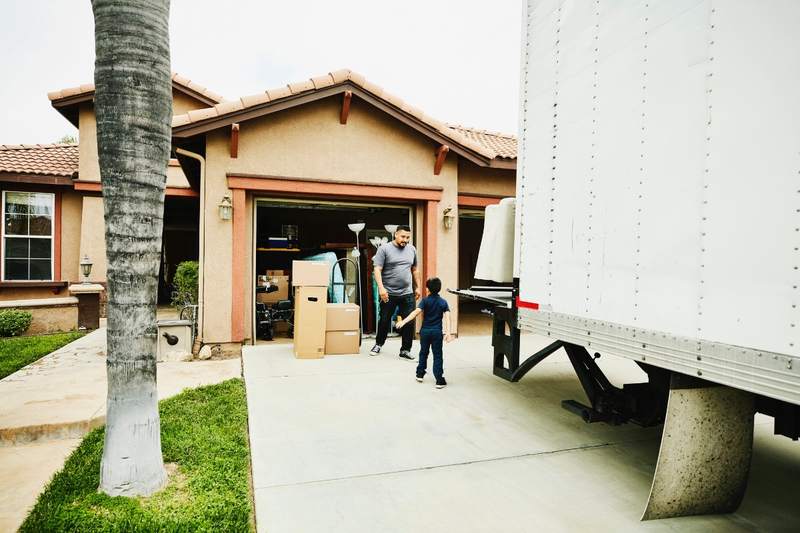If you want to buy a home, one of the first things you need to do is start saving for a down payment. Depending on the type of loan you use and the price of the home you want to buy, your down payment could easily be tens of thousands of dollars.
Here’s a plan to save for a down payment in six months.
Key Takeaways:
- Six months out is the time to focus on evaluating your savings and setting goals.
- In your six-month plan to save for a down payment, you should find ways to increase your income, cut unnecessary expenses, and look into down payment assistance programs.
- When you’re at the finish line, prepare to make your down payment and close on the home.
Is It Possible To Save For a Down Payment in 6 Months?
Though it might not be easy, it’s possible to save up for a down payment in six months. It all depends on your income, how much you already have saved, and how much you want to put down.
For example, imagine that you take home $5,000 each month after taxes. If you only spend $2,500 a month, you could save $15,000 in six months. If you already have around $10,000 saved, you’ll have $25,000 to put toward a down payment. This is enough to make a 5% down payment on a $495,100 home, which is the average home sales price in the second quarter of 2023.
On the other hand, if you’re barely making ends meet, it can be trickier because you have less extra cash to save. Still, with some effort and creativity, you can make good progress toward building a down payment fund.
Down payment requirements by loan type
Most people get a mortgage to buy a home, but not all mortgages are the same. There are a variety of loan programs geared toward different types of homes and borrowers. The loan program you use will impact how much you need for a down payment.
“Whether you’re new to real estate or have some experience, it’s essential for every potential homeowner, especially first-timers, to understand their mortgage options first,” says Kevin Martini, a Raleigh, North Carolina-based certified mortgage advisor. “Before diving into homeownership, it’s wise to begin by understanding home loans. This gives clear insights into the financial aspect and helps determine whether owning a home is viable.”
Minimum Down Payment Requirements for Common Types of Home Loans
| Loan Type | Minimum Down Payment |
| Conforming conventional loan | 3%, or 20% to avoid private mortgage insurance. |
| Nonconforming conventional loan (aka jumbo loan) | Varies by lender; often 10% to 20% or more. |
| Federal Housing Administration loan (aka FHA loan) | 3.5% |
| Department of Agriculture loan (aka USDA loan) | 0% |
| Department of Veterans Affairs loan (aka VA loan) | 0% |
6 Months Out
When you’re starting out, it’s time to set a goal for your savings and begin adjusting your habits so you can put more money toward your down payment fund.
Evaluate your savings
The first thing you should do is look at your financial situation. If you have some money set aside already, it will give you a head start on saving for a down payment.
According to Federal Reserve data from 2019, the most recent year for which the Fed collected this data, Americans have a median of $5,300 in savings. If you’re looking to save up a 3.5% down payment, that alone would be enough to get you halfway to a down payment on a $300,000 home.
Just keep in mind you should leave some money in your savings for an emergency fund.
Set a savings goal
Once you’ve assessed your starting point, you can think about how much you must save for a down payment and start setting goals. Your overall goal will depend on the price of the home you want to buy and the loan program that you choose.
“The first step to saving for a home is to clarify how much one needs to have and then create a saving plan to make it happen,” Martini says. “Likely, the amount required may be less than anticipated, but it can still be intimidating.”
For example, if you want to use a VA loan and are qualified, you don’t have to worry about saving for a down payment. Just focus on closing costs, moving expenses, the VA funding fee, and other costs.
If you want a conforming loan, you need to put at least 3% down. If you plan to buy a $500,000 home, that means you should aim to have $15,000 ready to meet the minimum down payment requirement.
Once you know your target, you can start working on building your savings.
Create a budget
A budget is key to being able to save effectively. You need to know how much money you have coming in — and where it all goes — to be able to change your habits and put more money into your house fund.
There are many ways to build a budget. Using a money tracking app that links with your bank and credit cards can be helpful. Most of these apps automatically categorize transactions so you can see what you’re spending your money on.
Other people prefer a more analog strategy, such as the envelope method. This involves putting cash into envelopes dedicated to specific types of purchases each month. When the envelope is empty, you’ve spent your budget for those purchases.
When creating your budget, be sure to dedicate a portion of your income to saving for a home. How much you save each month will determine whether you can come up with a down payment in six months.
Automate your savings
Once you know how much you can save for a home each month, you should automate the process of moving money to your down payment fund. It’s easier to save — and harder to overspend — if you don’t have to think about manually transferring money between accounts. You can automate your savings by setting up automatic transfers from your checking account to your savings account, or depositing a portion of your paycheck directly to your savings.
If you don’t have a high-yield savings account, it’s worth opening one to store your down payment fund. High-yield savings accounts offer much better returns on your savings than traditional savings accounts. While you won’t have much time to earn interest over a six-month period, every bit helps when you’re saving for a home.
Negotiate a raise at work
Your ability to save money is, in large part, limited by how much you make. If you make $4,000 a month, that means you can only save $4,000 a month, even if you manage to not spend a penny. If you make $8,000 per month, your ability to save doubles.
Negotiating a raise at work can be easier said than done, but it’s worth trying. Talk to your manager about adjusting your pay or how you can work toward a promotion that will come with an increase in your compensation. If you do land a raise, dedicate as much of that additional income as possible to saving for a down payment.
Pursue alternative income streams
As an alternative or supplement to asking for a raise at work, you can try to find other ways to earn income. A lot of Americans have a side hustle these days, with many believing that they’re all but essential to making ends meet.
Depending on your skills and interests, there are plenty of options out there, including:
- Driving for a rideshare service like Uber or Lyft.
- Delivering takeout from restaurants.
- Signing up to referee youth sports.
- Tutoring students online or in your area.
- Dog walking or pet sitting.
- Doing yardwork for people.
If you earn extra money and put it toward your house fund, it can accelerate your savings significantly.
5 Months Out
Once you figure out the income side of the equation, you can start working on your expenses. Remember, the less you spend, the more you can save.
Downsize and sell any clutter
The more you can downsize, the less space you’ll need in your new home. Smaller homes tend to be less expensive, which means you won’t need to save quite as much to afford a down payment.
Think about what you really need in a new home and how you could make do with less space, and do what you can to get rid of unnecessary things. If you’re already living in a small apartment, there won’t be much to do here, but if you’re renting a larger home, you might have to put in more effort.
As a bonus, you can try to sell any items that you decide that you don’t need or want to bring to your new home. Holding a yard sale to get rid of some old electronics, books, or furniture can boost your down payment fund. Plus, this could make it cheaper to hire movers.
Cut unnecessary expenses
Now that you have a budget, you should have a good sense of where you spend your money. That means you can start thinking about where you can reduce your spending.
When you’re saving for a big purchase, like a home, you should try to limit your spending wherever possible. That can include cutting unnecessary expenses, such as limiting the number of times you go out to eat.
For example, if you go to the movies every weekend, limiting yourself to once or twice a month could help you save an extra $100 or more every month. While that only adds about $500 to your down payment fund, every bit helps.
4 Months Out
As you get closer to the midway point of when you want to have your down payment ready, it’s important to stick to your plan and ensure you’re making good progress.
Check on your progress
After two months, you’re one-third of the way to your target date for buying a home. It’s a good time to check in and see if you’re making reasonable progress.
For example, if you started with no savings and want to have $12,000 by the time you buy a home, check to make sure you have about $4,000 saved. If you have more than that, you’re ahead of schedule. If you have less, you might need to adjust your expectations or work harder to increase your savings.
3 Months Out
At the halfway mark, it’s time to start thinking about finding a real estate agent and getting ready to go on house tours. You should also start preparing for the moving process.
Save at tax time
Depending on when you’re saving for a down payment, you might be filing your tax return during the process. If you get a tax refund, try to put as much of it as possible toward your down payment fund.
According to IRS data, 66% of taxpayers got a refund for their 2022 tax return, with an average refund of $3,039. That can provide a significant boost toward your savings goal.
Ask for cash gifts
If you have family or friends who want to help you buy a home, now is the time to start asking for cash gifts that you can put toward your down payment.
If you’re receiving a gift, it’s important that you get a gift letter from the person giving you the money. When you apply for a mortgage, your lender will want to know where your down payment funds are coming from. For all the lender knows, you might have gotten loans from other people, which could put you in a worse financial situation and leave you struggling to pay your mortgage.
Having a gift letter, which explicitly states that the giver is offering you funds with no expectation of repayment, will help the lender remain confident that you’ll be able to make your monthly mortgage payments.
The Finish Line
As you get ready to make a down payment on a home, there are a few last steps to take.
Look into down payment assistance programs
Down payment assistance programs can be a great source of money for your down payment. Often, these programs are aimed at low-income families looking to purchase a home.
For example, first-time buyers who meet income and asset limits in Boston can get grants for up to 5% of the purchase price of a home — up to $50,000 — to use for a down payment and closing costs.
Check with the government of the city or town you’re buying in, and also look up local nonprofits to learn about these opportunities.
Make your down payment
Once you’ve found a home, made an offer, and had the offer accepted by the seller, it’s time to make your down payment.
Often, you’ll have offered a portion of the down payment as earnest money when you made your offer, and provided additional earnest money once the offer was accepted. Earnest money shows the seller you’re serious about completing the purchase.
The remainder of the down payment is made during the closing process.
Close on the home
The final step is to close on the home. You’ll sit down and fill out a bunch of paperwork, completing the home purchase process. Once you sign the papers, the home is yours.
FAQ: How To Save For a Down Payment in 6 Months
Saving for a down payment in six months can be doable, but it might be difficult. Understanding the best ways to save will help.
Saving for a down payment in one month can be tricky. It will likely require already having a significant amount saved that can be put toward a down payment, and may involve using gifts from family. Saving for a down payment in one month can be much more difficult than saving for a down payment in six months if you aren’t already in a good financial position.
Saving for a down payment in a year involves many of the same steps as saving for a down payment over six months. However, the longer timeline means you can either save a larger amount or dedicate less to saving each month to reach your target.
The type of loan you apply for influences your down payment requirement. FHA loans, for example, only require a 3.5% down payment, while you might need 10%, 20%, or more for a jumbo loan. That means an FHA loan would be easier to save for. VA and USDA loans are even easier because they have no down payment requirement at all.
The Bottom Line on Saving For a Down Payment in 6 Months
Buying a home requires putting down a significant amount. On top of saving for a down payment, you should try to have money set aside for closing costs and moving expenses. You’ll also want an emergency fund so you can handle anything unexpected that pops up.
Though it can be difficult, with some effort, saving for a down payment in six months can be done. However, don’t be discouraged if it takes a bit longer. Come up with a savings plan, stick to it, and you should eventually reach your goal.
More From LowerMyBills:
- How To Save For a Down Payment on a Home
- How To Save For a Down Payment in 1 Year
- How To Prepare To Buy a House in 6 Months
- How To Prepare To Buy a House in 2 Years
- How Much Down Payment Do You Need To Buy a Home?
- Down Payment Assistance and Resources for First-Time Homebuyers
- The LowerMyBills Mortgage Calculator






